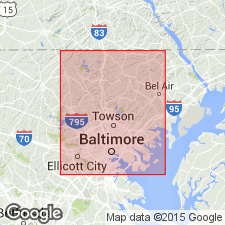
- Usage in publication:
-
- Raspeburg Amphibolite
- Modifications:
-
- Named
- Dominant lithology:
-
- Amphibolite
- AAPG geologic province:
-
- Piedmont-Blue Ridge province
Summary:
Name Raspeburg Amphibolite of the Baltimore Mafic Complex in the Bel Air belt is proposed for generally uniform, fine- to medium-grained plagioclase-hornblende amphibolite that crops out in the Raspeburg section of Baltimore City, MD. Contains rare, thin streaks of more felsic gneiss. Subtle layering and minor textural variations occur locally. North of Gunpowder Falls, the Raspeburg includes abundant, lighter colored, feldspathic amphibolite, four small outcrops of actinoschist, and two outcrops of talc-chlorite schist. Thickness varies from 0 to 1.2 km. Underlies Perry Hall Gneiss (new) in northeast-southwest syncline. To northeast, passes into Bradshaw Layered Amphibolite (new) of Baltimore Mafic Complex; in thrust-gault contact with Wissahickon Group. Interpreted to be, at least in part, of volcanic origin. Age of the entire Baltimore Mafic Complex given as Cambrian(?).
Source: GNU records (USGS DDS-6; Reston GNULEX).
For more information, please contact Nancy Stamm, Geologic Names Committee Secretary.
Asterisk (*) indicates published by U.S. Geological Survey authors.
"No current usage" (†) implies that a name has been abandoned or has fallen into disuse. Former usage and, if known, replacement name given in parentheses ( ).
Slash (/) indicates name conflicts with nomenclatural guidelines (CSN, 1933; ACSN, 1961, 1970; NACSN, 1983, 2005, 2021). May be explained within brackets ([ ]).

